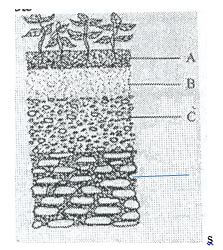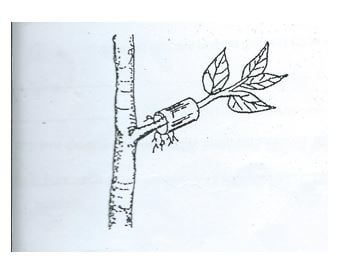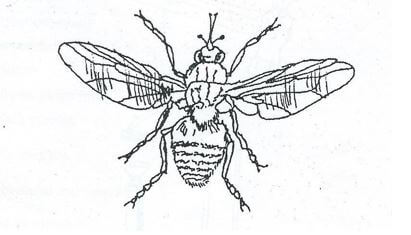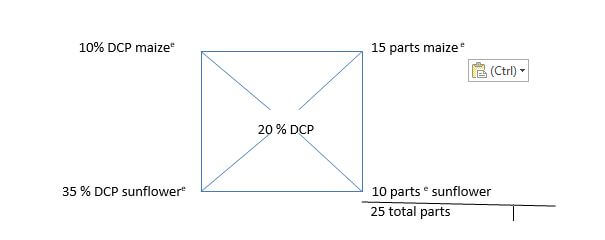INSTRUCTIONS TO STUDENTS
- This paper has three sections A,B and C
- Answer ALL the questions in section A and B
- Answer only TWO questions in section C
SECTION A
Answer ALL the questions in this section
- Differentiate between apiculture and aquaculture (1mk)
- Name four methods of farming (2mks)
- State four possible uses of income earned from sale of agricultural produce (2mks)
- List four human factors that influence agriculture (2mks)
- Give four reasons for treating water for use on the farm (2mks)
- State the use of each of the following farm tool listed below (2mks)
Sickle…………………………………………………………………………………………..
Milk churn………………………………………………………………………………………
Elastrator………………………………………………………………………………………..
Drenching gun………………………………………………………………………………….. - State four precautions that should be observed when using workshop tools (2mks)
- Give four reasons why burning is discouraged as a method of land clearing (2mks)
- Name four practices that enhance minimum tillage (2mks)
- Give two sources of underground water (1mk)
- State four characteristics of a fertile soil (2mks)
- Name four breeds of dairy goats (2mks)
- Name two types of labour records (1mk)
- List four symptoms of Nitrogen deficiency in plants (2mks)
- Name two vegetative materials used to propagate pineapples (1mk)
- Outline four factors considered when selecting a nursery site (2mks)
- State four characteristics of a good grain store (2mks)
SECTION B
- Answer ALL the questions in this section
- The following is a list of plant nutrients; copper, calcium, nitrogen, zinc, molybdenum, phosphorus, carbon, sulphur, iron and magnesium.
Which of the above nutrients are?- Macro elements (2mks)
- Micro elements (1mk)
- Fertilizer elements (1mk)
- Liming elements (1mk)
- The diagram below illustrates a feature observed after digging the soil several meters deep. Study the diagram carefully and answer the questions that follow

- Identify the feature that the diagram above represents in the study of soil (1mk)
- Name the parts on the diagram labelled A,B,C and D (2mks)
- State two ways in which the knowledge of the above feature would be of benefit to a farmer (2mks)
- the diagram below illustrates a nursery practice

- identify the practice (1mk)
- describe the procedure followed in carrying out the practice illustrated (2mks)
- state two advantages of the practice illustrated above in crop production (2mks)
- The diagram below illustrates a livestock parasite

- identify the parasite illustrated above (1mk)
- state the major harmful effect of the parasite (1mk)
- explain three control measures of the parasite (3mk)
SECTION C
Answer only two questions in this section
- Explain the importance of vegetables to a farmer (5mks)
- Briefly describe the production of onions under the following sub-headings
- Varieties (1mk)
- Ecological requirements (3mks)
- Land preparation (3mks)
- Field management practices (4mks)
- Harvesting and marketing (4mks)
-
- Define the following terms as used in livestock health (2mks)
- Disease……………………………………………………………………………………………………………
- Health……………………………………………………………………………………………………………
- State four pre-disposing factors of livestock diseases(2mks)
- Give reasons for keeping livestock healthy (6mks)
- Outline methods a farmer can use to control livestock diseases (5mks)
- Describe the harmful effects of parasites on livestock (5mks)
- Define the following terms as used in livestock health (2mks)
-
- Explain five advantages of crop rotation (10mks)
- Outline five activities that may be undertaken in organic farming (5mks)
- A farmer wanted to prepare 200kg of calf rearing ration containing 20 % DCP , using the pearsons square method calculate the amount of maize containing 18% DCP and sunflower containing 35% DCP the framer would need to prepare.(5mks show your working)
MARKING SCHEME
-
- Apiculture- rearing of bees in bee hive
- Aquaculture – rearing of fish in fish ponds (mark as a whole 1mk)
-
- Shifting cultivation
- Nomadic pastoralism
- Organic farming
- Agroforestry
- Mixed farming (4*1/2= 2mks)
-
- Paying workers in the farm
- Buying farm inputs e.g. seeds
- Starting up small businesses
- Improving living standards
- Some income may be taxed by government to fund developmental projects (4*1/2 = 2mks)
-
- Level of education and technology
- Health (HIV and AIDS and health in general
- Economy
- Government policy
- Transport and communication
- Cultural practices and religious believes
- Market forces (4*1/2 = 2mks)
-
- To kill disease causing microorganismse.g. cholera
- To remove chemical impurities e.g. excess fluoride
- To remove smells and bad taste
- To remove sediments of solids e.g. sand, sticks (4*1/2 = 2mks)
-
- Sickle – for cutting back pyrethrum stalks, harvesting rice and other grasses
- Milk churn - holding milk in transit and storage
- Elastrator – expanding the rubber ring during castration
- Drenching gun – administering liquid drugs through the mouth of an animal (4*1/2 = 2mks)
-
- Leave the tool in a safe place after use
- Use the correct tool for the correct job
- Proper handling of tool to avoid damage of the tool and injury to the user
- Proper maintenance of tool to keep it in good working conditions
- Store tools properly in cabinets or tool racks to avoid wear and tear or injuries during working
- Maintain safe working environment by installing fire extinguishers and first aid kits to reduce accidents e.g. in welding (4*1/2 = 2mks)
-
- Destroys soil structure
- Kills important soil micro organisms
- Causes evaporation of the available moisture
- Leaves the land bare and exposed to agents of soil erosion
- Fire may spread to unintended crops
- Causes accumulation of potash which changes soil PH
- Causes loss of nutrients through volatilisation (4*1/2 = 2mks)
-
- Use of herbicides
- Mulching
Cover cropping - Uprooting or slashing weeds
- Restricting cultivation where seeds are to be planted
- Timing cultivation e.g. late weeding in cotton produces clan seedbed for sowing finger millet (4*1/2 = 2mks)
-
- Springs
- Wells
- Boreholes (2*1/2 = 1mk)
-
- Good depth
- Well drained
- Good water holding capacity
- Has adequate nutrient supply
- Has correct PH
- Free from excessive infestation of soil borne pest and diseases (4*1/2 = 2mks)
-
- British alpine
- Saanen
- Toggenburg
- Jamnapari
- Anglo – Nubian (4*1/2 = 2mks)
-
- Muster roll
- Labour utilisation analysis (2*1/2 = 1mk)
-
- Leaf chlorosis
- Stunted growth
- Leaves turn brown and fall off prematurely
- Production of anthocyanin (purple colour) e.g. in tomatoes (4*1/2 = 2mks)
-
- Suckers
- Crown
- Slips (2*1/2 = 1mk)
-
- Type of soil
- Near a water source
- Topography
- Previous cropping
- Security
- Well sheltered place (4*1/2 = 2mks)
-
- Should be well ventilated
- Rat or vermin proof
- Easy to load and off load
- Pest – free
- Should have leak proof roof
- Well secured to minimise thefts
- Should provide cool conditions to prevent cracking of grains (4*1/2 = 2mks)
SECTION B
-
-
- calcium
- Nitrogen
- Phosphorus
- Carbon
- Sulphur
- Magnesium (4*1/2 = 2mks)
-
- Copper
- Molybdenum
- Zinc
- Iron (2*1/2 = 1mk)
-
- Nitrogen
- Phosphorus (2*1/2 = 1mk)
-
- Calcium
- Sulphur
- Magnesium (2*1/2= 1mks)
-
-
-
- Soil profile (1mk)
-
- A Topsoil
- B Sub soil
- C Substratum /weathered rocks
- D Parent rock material (4*1/2=2mks)
-
- Helps farmer to choose the appropriate crop to grow
- Helps to determine depth of ploughing
- Helps farmer to determine the kind of foundations for farm structures (2*1mk=2mks)
-
-
-
- Aerial layering/ marcotting (1mk)
-
- Select healthy woody branch
- Remove the bark and cambial layer from a section of the branch/ring back the branch
- Heap moist rooting medium around the section
- Wrap the rooting medium with polythene sheet (2mks)
-
- Used to obtain large planting materials
- Used to propagate plants whose branches cannot bend to the ground (2mks)
-
-
-
- Tsetse fly (1mk)
-
- Transmits Trypanasomiasis/ nagana (1mk)
-
- Bush clearing to destroy breeding site
- Spraying insecticide to kill them
- Trapping and killing
- Sterilizing male flies to impair breeding
- Use impregnate nets to kill them
- Creating a buffer zone between game reserves and livestock areas to isolate them (1*3=3mks)
-
SECTION C
-
- Importance of vegetables to a farmer
- Source of income when sold by farmer
- Source of food for consumption by the farmer
- Provides animals with vitamins and minerals e.g. calcium for proper growth and animals performance
- Can be used to prepare organic manure
- Vegetables not used for consumption can be fed to livestock (1*5=5mks)
-
- Onion varieties
- Red creole
- White creole
- Tropicana hybrid (2*1/2mk =1mk)
- Ecological requirements
- Altitude – 2100 meters above sea level
- Soil should be deep, well drained fertile soil
- PH slightly acidic (6.0 – 7.0)
- Rainfall – 1000 mm / year. Rainfall should be well distributed throughout the growing period. Dry spell is required during ripening of the bulbs (any three points well explained 3mks)
- Land preparation
- Prepare land during the dry spell
- Clear vegetation and remove all the weeds
- Prepare seedbed to a fine tilt
- Apply farmyard manure 40 -50 tonnes / ha (3mks)
- Field management
- Thinning – done to achieve distance of 8cm between the plants when onion is directly planted in the seedbed
- Weeding avoid compacting soil around the bulbs. Avoid damaging the shallow roots when weeding
- Watering done during the dry spell to supply moisture to the crops
- Topdressing apply Calcium Ammonium Nitrate fertilizer (CAN) 250 kg/ha three weeks after planting to hasten growth
- Pest control – use suitable appropriate recommended insecticide to control onion-thrips
- Disease control use suitable appropriate recommended fungicide to control purple blotch
(Any four points well explain 4mks)
- Harvesting and marketing
- Harvest the bulbs five months after planting
- When the leaves start drying their tops should broken or bent at the neck.
- Dig up the bulbs and dry them under shade
- Turn the bulbs daily for even drying
- Store the bulbs in slatted boxes
- Grade the bulbs according to size and market them in net bags (4mks)
- Onion varieties
- Importance of vegetables to a farmer
-
-
- Disease deviation from the normal functioning of organs or system which interrupts proper functioning of animal’s body (1mk)
- Health state in which all body organs and systems are considered normal and functioning normally (1mk)
-
- Age of the animal
- Sex of the animal
- Species of the animal
- Breed of the animal
- Colour of the animal
- Physical injuries e.g. wounds
- Weather condition e.g. cold predisposes calves to pneumonia
- Congestion (4*1/2=2mks)
-
- It helps to reduce medication cost
- Healthy animals grow faster hence reach maturity faster
- Healthy animals have high productivity
- Healthy animals will not spread disease to other animals or to human beings
- Healthy animals produce quality products hence high marketability
- Healthy animals have long productive life
- Healthy animals give birth to healthy offspring (6mks)
-
- Isolation of sick animals
- Imposition of quarantine
- Slaughtering of affected animals
- Proper feeding and nutrition
- Proper breeding and selection
- Proper housing and hygiene
- Use of antiseptics and disinfectants to enhance hygiene in livestock houses and surroundings
- Prophylactic measures and treatment which include
- Use of prophylactic drugs
- Regular vaccination
- Control of vectors
- Treatment of sick animals (5mk)
-
- They suck blood causing anaemia
- They cause irritation through their bites
- They obstruct internal organs
- They transmit diseases
- They cause injuries to the tissues and organs through their bites
- They deprive the host animal of food (5mks)
-
-
-
- Ensures maximum utilisation of nutrients when heavy nutrient feeders are alternated with light nutrient feeders
- Improves soil structure when grass ley is included in the programme
- Improves soil structure when legume crop is included in the programme
- Controls soil erosion by alternating crops planted in rows with cover crops
- Controls weeds e.g.Striga spp which is specific to grass family crops
- Controls soil borne pests and disease build up(Award 1mk for stating and 1mk for explaining 5*2=10mks)
-
- Mulching
- Cover cropping
- Crop rotation
- Double digging
- Biological pest control
- Observing close season (1*5mks)

- Maize → 15/25 x 200= 120 kg. (1mk)
- Sunflower parts → 10/25 x 200= 80 kg (1mk)
-
Download Agriculture Form 2 Questions and Answers - Term 3 Opener Exams 2021.
Tap Here to Download for 50/-
Get on WhatsApp for 50/-
Why download?
- ✔ To read offline at any time.
- ✔ To Print at your convenience
- ✔ Share Easily with Friends / Students

